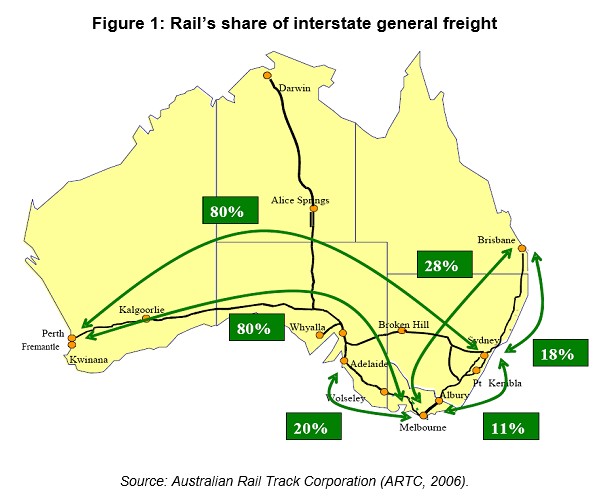The upcoming May Budget is expected to commit more than $1 billion to building an inland rail line between Melbourne and Brisbane. From The ABC:
The Federal Government is set to give the construction of an inland rail network a kick-along, with an allocation of more than $1 billion.
The ABC understands the money will be made available in next month’s budget, although the Cabinet’s expenditure review committee is yet to decide on a final figure.
Farmers and the freight industry have lobbied governments for decades to build the inland rail — a $10 billion direct line that would move goods from Brisbane to Melbourne in less than 24 hours.
It would also link south-east Queensland with Perth and Adelaide.
Infrastructure Minister Darren Chester would not confirm the amount being allocated but said the Government was committed to completing the project.
“I will not speculate on what is in the budget, but what I will say is that the inland rail project is a critically important piece of infrastructure that the Turnbull-Joyce Government is committed to building,” he said.
“The Prime Minister’s already indicated that he wants construction to start in 2017 and that will occur”…
The Coalition allocated $593 million to buy land for the inland rail project in last year’s budget and Labor allocated $900 million to the project when it was in government.
This is great news if it is true.
Building an inland rail freight network from Melbourne and Brisbane (including connections to Sydney) has a lot of merit, along with building world class intermodal connections at key locations along the way so transfers between rail and truck are fast and efficient.
Rail is particularly well suited to two types of freight:
- Bulk Freight: rail is suited to the provision of high volume bulk freight services to export facilities because it generally requires well defined point-to-point transport only (such as directly from silo/mine to port) with no requirement for trucking at any intermediate points. Rail can also transport larger volumes in shorter periods to meet shipping requirements and minimise on-port storage.
- Long-haul General (Containerised) Freight: Road has inherent competitive advantages in the transportation of short-haul general freight because of its ability to offer a flexible door to door service without modal transfer (i.e. transfer to/from rail) and its capacity to handle small shipment sizes. However, rail tends to be more price competitive over longer distances where pick-up-and-delivery costs are reduced in unit cost per kilometre terms.
However, despite the long distance between Melbourne and Brisbane, rail’s share of general freight was just 28% in 2006, whereas it was 80% between the East Coast and Perth (see below).

A key reason why rail’s share is so low is because it shares the track with the passenger rail network in Sydney, which has priority. The existing rail freight network is also in poor condition. This makes rail freight far slower and less reliable than road transport, despite what should be a strong natural advantage (i.e. the very long distance travelled).
The end result is that thousands of truck trips are taken between Melbourne and Brisbane when, given decent infrastructure, rail could easily be fulfilling the role instead.
Accordingly, road trauma is higher than would otherwise be the case, as are greenhouse gas emissions, given one long freight train could replace around 110 B-Double trucks. Producers are also forced to endure higher costs in delivering their goods to port, thus reducing their competitiveness.
The $10 billion estimated cost of building an inland rail freight line is also a tiny fraction of the circa $100 billion estimated cost of building a HSR passenger network, which has received far more attention despite dubious economic benefits.

